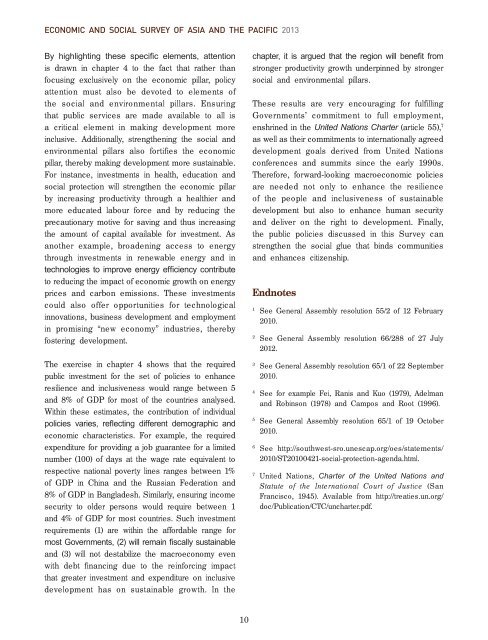Full Report - Subregional Office for East and North-East Asia - escap
Full Report - Subregional Office for East and North-East Asia - escap
Full Report - Subregional Office for East and North-East Asia - escap
You also want an ePaper? Increase the reach of your titles
YUMPU automatically turns print PDFs into web optimized ePapers that Google loves.
ECONOMIC AND SOCIAL SURVEY OF ASIA AND THE PACIFIC 2013<br />
By highlighting these specific elements, attention<br />
is drawn in chapter 4 to the fact that rather than<br />
focusing exclusively on the economic pillar, policy<br />
attention must also be devoted to elements of<br />
the social <strong>and</strong> environmental pillars. Ensuring<br />
that public services are made available to all is<br />
a critical element in making development more<br />
inclusive. Additionally, strengthening the social <strong>and</strong><br />
environmental pillars also <strong>for</strong>tifies the economic<br />
pillar, thereby making development more sustainable.<br />
For instance, investments in health, education <strong>and</strong><br />
social protection will strengthen the economic pillar<br />
by increasing productivity through a healthier <strong>and</strong><br />
more educated labour <strong>for</strong>ce <strong>and</strong> by reducing the<br />
precautionary motive <strong>for</strong> saving <strong>and</strong> thus increasing<br />
the amount of capital available <strong>for</strong> investment. As<br />
another example, broadening access to energy<br />
through investments in renewable energy <strong>and</strong> in<br />
technologies to improve energy efficiency contribute<br />
to reducing the impact of economic growth on energy<br />
prices <strong>and</strong> carbon emissions. These investments<br />
could also offer opportunities <strong>for</strong> technological<br />
innovations, business development <strong>and</strong> employment<br />
in promising “new economy” industries, thereby<br />
fostering development.<br />
The exercise in chapter 4 shows that the required<br />
public investment <strong>for</strong> the set of policies to enhance<br />
resilience <strong>and</strong> inclusiveness would range between 5<br />
<strong>and</strong> 8% of GDP <strong>for</strong> most of the countries analysed.<br />
Within these estimates, the contribution of individual<br />
policies varies, reflecting different demographic <strong>and</strong><br />
economic characteristics. For example, the required<br />
expenditure <strong>for</strong> providing a job guarantee <strong>for</strong> a limited<br />
number (100) of days at the wage rate equivalent to<br />
respective national poverty lines ranges between 1%<br />
of GDP in China <strong>and</strong> the Russian Federation <strong>and</strong><br />
8% of GDP in Bangladesh. Similarly, ensuring income<br />
security to older persons would require between 1<br />
<strong>and</strong> 4% of GDP <strong>for</strong> most countries. Such investment<br />
requirements (1) are within the af<strong>for</strong>dable range <strong>for</strong><br />
most Governments, (2) will remain fiscally sustainable<br />
<strong>and</strong> (3) will not destabilize the macroeconomy even<br />
with debt financing due to the rein<strong>for</strong>cing impact<br />
that greater investment <strong>and</strong> expenditure on inclusive<br />
development has on sustainable growth. In the<br />
chapter, it is argued that the region will benefit from<br />
stronger productivity growth underpinned by stronger<br />
social <strong>and</strong> environmental pillars.<br />
These results are very encouraging <strong>for</strong> fulfilling<br />
Governments’ commitment to full employment,<br />
enshrined in the United Nations Charter (article 55), 7<br />
as well as their commitments to internationally agreed<br />
development goals derived from United Nations<br />
conferences <strong>and</strong> summits since the early 1990s.<br />
There<strong>for</strong>e, <strong>for</strong>ward-looking macroeconomic policies<br />
are needed not only to enhance the resilience<br />
of the people <strong>and</strong> inclusiveness of sustainable<br />
development but also to enhance human security<br />
<strong>and</strong> deliver on the right to development. Finally,<br />
the public policies discussed in this Survey can<br />
strengthen the social glue that binds communities<br />
<strong>and</strong> enhances citizenship.<br />
Endnotes<br />
1<br />
See General Assembly resolution 55/2 of 12 February<br />
2010.<br />
2<br />
See General Assembly resolution 66/288 of 27 July<br />
2012.<br />
3<br />
See General Assembly resolution 65/1 of 22 September<br />
2010.<br />
4<br />
See <strong>for</strong> example Fei, Ranis <strong>and</strong> Kuo (1979), Adelman<br />
<strong>and</strong> Robinson (1978) <strong>and</strong> Campos <strong>and</strong> Root (1996).<br />
5<br />
See General Assembly resolution 65/1 of 19 October<br />
2010.<br />
6<br />
See http://southwest-sro.un<strong>escap</strong>.org/oes/statements/<br />
2010/ST20100421-social-protection-agenda.html.<br />
7<br />
United Nations, Charter of the United Nations <strong>and</strong><br />
Statute of the International Court of Justice (San<br />
Francisco, 1945). Available from http://treaties.un.org/<br />
doc/Publication/CTC/uncharter.pdf.<br />
10












